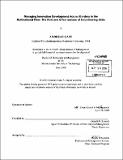| dc.contributor.advisor | Donald R. Lessard. | en_US |
| dc.contributor.author | Gast, Andreas | en_US |
| dc.contributor.other | Sloan School of Management. | en_US |
| dc.date.accessioned | 2005-08-23T12:00:00Z | en_US |
| dc.date.available | 2005-08-23T12:00:00Z | en_US |
| dc.date.copyright | 2000 | en_US |
| dc.date.issued | 2000 | en_US |
| dc.identifier.uri | http://hdl.handle.net/1721.1/9286 | |
| dc.description | Thesis (Ph.D.)--Massachusetts Institute of Technology, Sloan School of Management, 2000. | en_US |
| dc.description | Includes bibliographical references (leaves 159-172). | en_US |
| dc.description.statementofresponsibility | by Andreas Gast. | en_US |
| dc.format.extent | 172 leaves | en_US |
| dc.format.extent | 20773291 bytes | |
| dc.format.extent | 20773048 bytes | |
| dc.format.mimetype | application/pdf | |
| dc.format.mimetype | application/pdf | |
| dc.language.iso | eng | en_US |
| dc.publisher | Massachusetts Institute of Technology | en_US |
| dc.rights | M.I.T. theses are protected by copyright. They may be viewed from this source for any purpose, but reproduction or distribution in any format is prohibited without written permission. See provided URL for inquiries about permission. | en_US |
| dc.rights.uri | http://dspace.mit.edu/handle/1721.1/7582 | |
| dc.subject | Sloan School of Management. | en_US |
| dc.title | Managing innovation development across borders in the multinational firm : the role and effectiveness of coordinating units | en_US |
| dc.type | Thesis | en_US |
| dc.description.degree | Ph.D. | en_US |
| dc.contributor.department | Sloan School of Management | |
| dc.identifier.oclc | 45752876 | en_US |
| dc.date.updated | For multinational firms in many industries, cross-border innovation development - the process of combining capabilities from units in several countries to create new products, services or ways of doing business - is an increasingly important source of competitive advantage. However, in order to reap its benefits, the firms need to overcome significant organizational obstacles. One of them is the need to find an effective balance between local unit initiative and central intervention, between horizontal cooperation and vertical coordination. The current study focuses on the role of central coordination units, like corporate, divisional and regional headquarters, in cross-border innovation development projects. It also examines conditions that influence how effectively the coordinating units support cooperation among local units in these projects. The study combines interviews that provide information richness and a survey that allows larges ample testing of hypotheses. Based on exploratory case work in three countries and a review of the literatures, the research framework is developed and tested with a survey of large multinational firms in various industries. The quantitative analyses use data from 3 firms with 40 innovation development projects and 101 participating organizational units. According to the results, the roles of central units depend mostly on their comparative unit specific advantages vis-a-vis the local units, seen in terms of resources, inter-unit relations, cultural differences, uncertainty, and motivation. Their effectiveness is jointly determined by the size of their comparative advantages and various aspects of project coorc~ination complexity. The findings support the notion of differentiated fit in multinational firms, and reveal current capability boundaries. The study contributes to the international management literature a better understanding of crossborder innovation development. It complements previous, mostly case-based research with quantitative analysis. To the strategy and capability literatures, it adds insights about a dynamic capability that increasingly affects firm performance, and shows when central units can add value to the activities of local units. To the innovation management literature, it adds a contingency view of central support and an exploration of links between innovation development and subsequent innovation transfers. Practitioners may also find th~ implications for capability development, knowledge management and innovation project management useful. | en_US |

